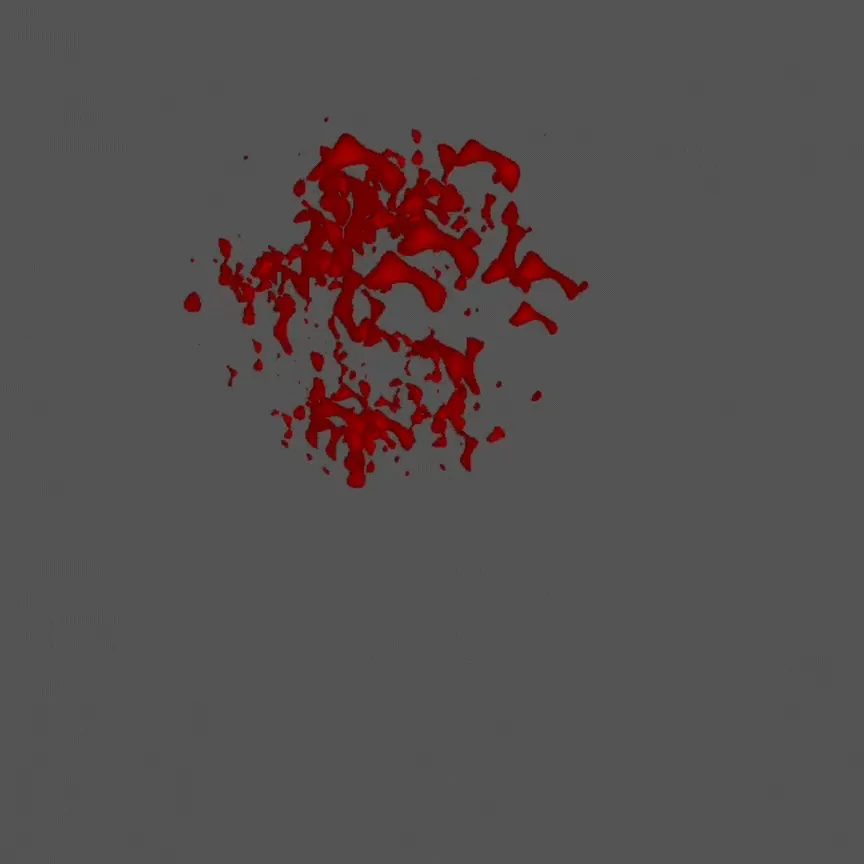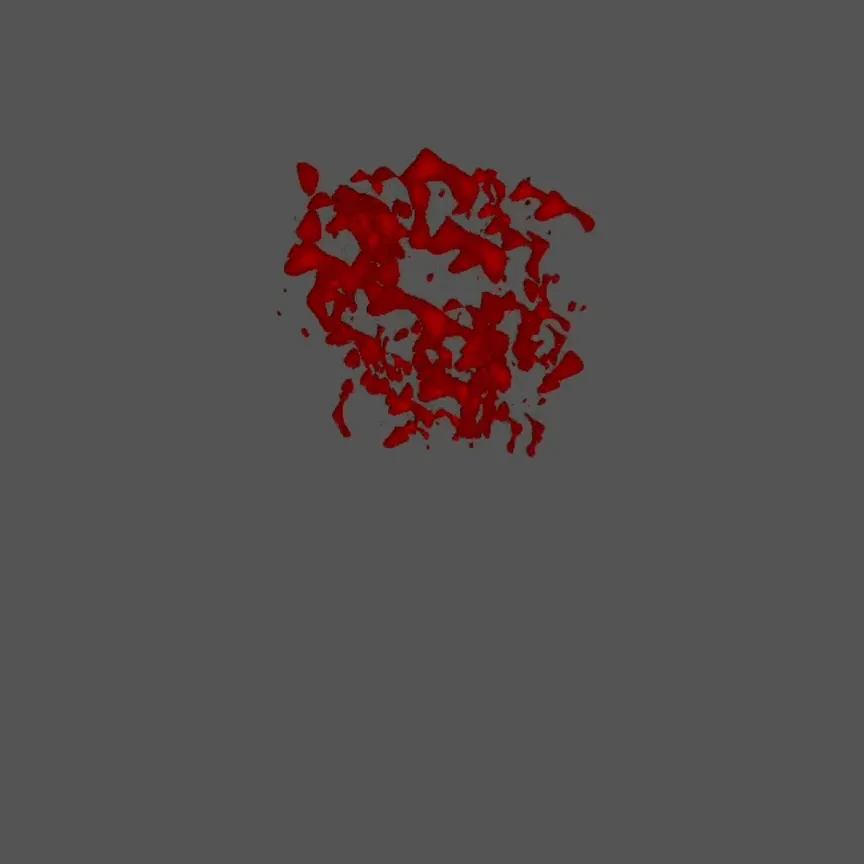Splash and Splatter Shaders


This page covers two Godot spatial shaders that create dynamic splash and splatter effects. The splash shader is used for airborne impacts—think blood spurts or liquid bursts—while the splatter shader handles stains left behind on surfaces. Both help to enhance visual feedback during gameplay.
Splash Shader Code
Section titled “Splash Shader Code”shader_type spatial;render_mode blend_mix, depth_draw_opaque, cull_back, unshaded;
instance uniform vec4 main_color : source_color = vec4(0.7, 0.02, 0.01, 1.0);uniform sampler2D noise_texture;uniform float distortion_amount : hint_range(0.0, 0.5, 0.01) = 0.1;uniform float noise_power : hint_range(-5.0, 10.0, 0.1) = 5.0;uniform float base_alpha : hint_range(0.0, 1.0, 0.01) = 0.8;uniform float angle_influence : hint_range(0.0, 1.0, 0.01) = 0.5;uniform float gradient_strength : hint_range(0.0, 10.0, 0.1)= 2.0;
void vertex() { mat4 billboard_matrix = VIEW_MATRIX; billboard_matrix[0] = VIEW_MATRIX * INV_VIEW_MATRIX[0]; billboard_matrix[1] = VIEW_MATRIX * INV_VIEW_MATRIX[1]; billboard_matrix[2] = VIEW_MATRIX * INV_VIEW_MATRIX[2]; billboard_matrix[3] = VIEW_MATRIX * MODEL_MATRIX[3];
billboard_matrix[0][0] = length(MODEL_MATRIX[0].xyz); billboard_matrix[1][1] = length(MODEL_MATRIX[1].xyz); billboard_matrix[2][2] = length(MODEL_MATRIX[2].xyz);
MODELVIEW_MATRIX = billboard_matrix; COLOR.r = float(INSTANCE_ID); COLOR.g = 0.0; COLOR.b = 0.0;}
void fragment() { vec2 center = vec2(0.5); vec2 dir = UV - center; float radius = length(dir) * gradient_strength; float angle = atan(dir.y, dir.x) / (PI * 2.0); float gradient = 1.0 - max(radius, angle * angle_influence);
float distortion_strength = COLOR.r * distortion_amount; vec2 distorted_uv = UV + vec2(distortion_strength); float texture_value = pow(texture(noise_texture, distorted_uv).r, noise_power);
vec3 final_color = main_color.rgb * (vec3(gradient) * vec3(texture_value)); float alpha_threshold = 1.0 - (gradient * texture_value);
ALBEDO = final_color; ALPHA = base_alpha; ALPHA_SCISSOR_THRESHOLD = alpha_threshold;}What It Does
Section titled “What It Does”The splash shader combined with GPUParticles3D creates a dynamic, camera-facing blood splash effect. It uses a combination of billboarding, noise-based distortion, and gradient masking to simulate airborne splash impacts.
- Billboarding: Ensures the splash always faces the camera, regardless of object rotation.
- Noise Distortion: Uses a noise texture and per-instance distortion for organic, non-repetitive shapes.
- Gradient Mask: Fades the splash from the center outward, with angle-based variation for irregular edges.
- Alpha Scissor: Sharp cutouts for realistic, non-uniform transparency.
Shader Parameters
Section titled “Shader Parameters”main_color: Base color of the splash (can be varied per instance).noise_texture: Texture for randomizing splash shape.distortion_amount: How much the splash is warped.noise_power: Controls the contrast of the noise.base_alpha: Overall transparency.angle_influence: How much the splash’s angle affects its fade.gradient_strength: Controls the radial fade from the center.
Splatter Shader Code
Section titled “Splatter Shader Code”shader_type spatial;render_mode blend_mix, depth_draw_opaque, cull_back, diffuse_lambert, specular_schlick_ggx;
instance uniform vec4 main_color : source_color = vec4(0.7, 0.02, 0.01, 1.0);uniform sampler2D noise_texture;uniform float splatter_scale = 2.0;uniform float distortion_amount : hint_range(0.0, 1.0, 0.01) = 0.1;uniform float edge_variation : hint_range(0.0, 1.0, 0.01) = 1.0;uniform float noise_power : hint_range(1.0, 10.0, 0.1) = 1.0;
void vertex() { COLOR.r = float(INSTANCE_ID); COLOR.g = INSTANCE_CUSTOM.y; COLOR.b = 0.0;}
void fragment() { vec2 center = vec2(0.5); vec2 uv_dir = (UV - center) / splatter_scale; float radius = length(uv_dir) * 2.0; float gradient = 1.0 - radius;
float distortion_strength = COLOR.r * distortion_amount; vec2 distorted_uv = UV + vec2(distortion_strength) / splatter_scale; float texture_value = pow(texture(noise_texture, distorted_uv).r, noise_power);
float mask = gradient * texture_value; float edge_fade = 1.0 - COLOR.g * edge_variation; vec3 final_color = main_color.rgb * vec3(mask);
ALBEDO = final_color; ALPHA = edge_fade * mask; ALPHA_SCISSOR_THRESHOLD = 1.0 - mask;}What It Does
Section titled “What It Does”The splatter shader simulates blood stains on surfaces, such as floors or walls. It uses lighting models for realistic interaction with the environment and edge fading for natural decay.
- Diffuse & Specular Lighting: Reacts to scene lighting for a wet, shiny look.
- Noise & Distortion: Adds randomness for organic, non-uniform stains.
- Edge Variation: Allows splatters to fade or change over time.
- Alpha Scissor: Creates sharp, irregular edges.
Shader Parameters
Section titled “Shader Parameters”main_color: Base color of the splatter.noise_texture: Texture for randomizing splatter shape.splatter_scale: Controls splatter size.distortion_amount: Amount of UV distortion.edge_variation: Controls edge fading (can be animated).noise_power: Adjusts noise contrast.
Usage in Fowl Play
Section titled “Usage in Fowl Play”Both shaders are used to visually reinforce the impact of combat. The splash shader is for airborne, momentary effects (like blood spurts), while the splatter shader is suited for persistent stains on surfaces. Their parameters allow for variation and tuning to match the dark, gritty tone of the game.
Technical Notes
Section titled “Technical Notes”Billboardingin the Splash Shader ensures the effect always faces the camera, using the view and model matrices.Instance IDsare used to randomize distortion and edge effects per particle or decal.Noise Texturesshould be seamless and grayscale for best results.Alpha Scissoris used in both shaders to discard pixels below a threshold, creating sharp, organic edges.